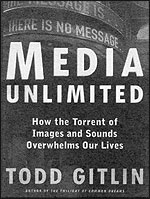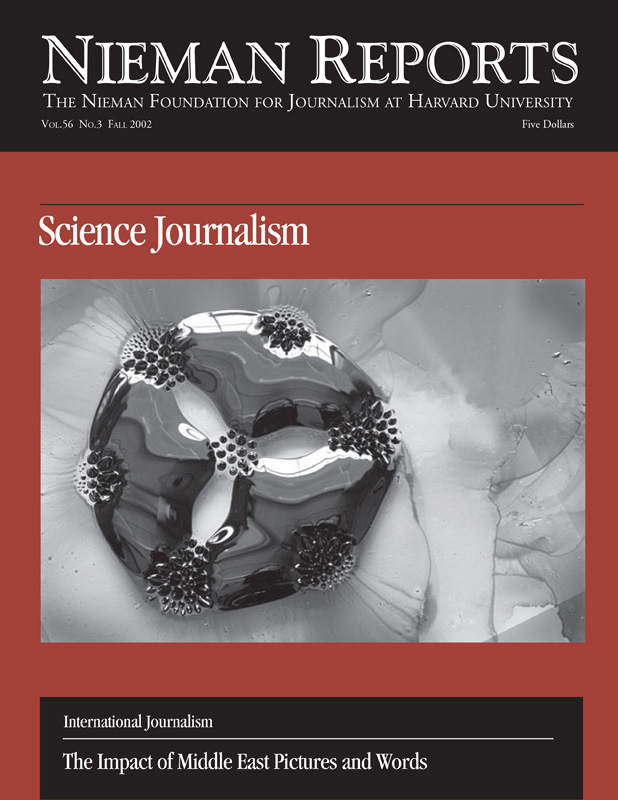
Media Unlimited
How the Torrent of Images and Sounds Overwhelms Our Lives
Todd Gitlin
Metropolitan Books. 260 Pages. $25.
When people talked about the “media” 10 years ago, they usually meant the “news media.” And, more often than not, they were unhappy with what they saw, according to polls by Andrew Kohut and other analysts. “People are incredibly angry at the media. They think that all the media moguls and journalists have access to massive amounts of information that the public doesn’t ever see,” observed scholar Margaret Gordon of the University of Washington after conducting focus groups in Seattle during the 1992 presidential campaign.
But something shifted by the time Todd Gitlin sat down to write “Media Unlimited,” his new book. To Gitlin, “media” aren’t really about journalism at all, or about anything real. They are an alternative universe, a parade of surrogate experiences and disposable feelings, delivered through films, television, music, radio, advertising, print publishing, cell phones, and computer games. Now America’s “vast circus maximus, our cultural jamboree of jamborees” has become a central experience of modern life, seducing the entire globe with pointless pleasure.
What Gitlin notices most about this media arcade is that it requires nothing from us, not even our attention. Everything is made to be taken lightly and to pass by quickly. We are zombies, strapped into roller coasters. Part of the thrill is the speed of the media ride. None of it is real, but it sure is fun, Gitlin reports.
A famous chronicler of the sixties who is a professor of journalism and sociology at Columbia University, Gitlin seems oddly unperturbed by the trends he examines. He portrays media as one might describe a prostitute, offering sensual engagement that demands nothing and means nothing except a moment’s pleasure and a bit of commerce. There is no Gitlin handwringing about the degradation this implies.
The constantly changing media environment is anti-intellectual, and “accomplished language is, if anything, an impediment,” he notes. Gitlin’s perspective of journalism is that for its audiences it is just another sideshow, full of sound and fury, signifying nothing. Trying to bear witness and report the facts seems pointless in Gitlin’s world, since the media audience is not trying to construct meaning, but to flee from it. Embracing Neal Gabler’s view that the owners of the penny press invented news to be more efficient entertainment, Gitlin emphasizes that media images are “not supposed to help us discern reality; they are supposed to deliver feelings and sensations.” Indeed, in the case of network television, Gitlin’s extreme vision may be coming true, as more executives abandon their news audiences (such as ABC’s idea of replacing Ted Koppel with David Letterman), because entertainment is so much easier to monetize.
At least Gitlin’s “the media have no message” analysis challenges the old canard that most journalists are sneaky ideologues from the left or the right. “Political critics, convinced that the media are rigged against them, are often blind to other substantial reasons why their causes are unpersuasive,” Gitlin observes. The less popular the cause, the more likely its proponents will blame the news media for its failure. Nevertheless, conservatives do play better on television, he correctly discovers, because the medium favors a simple, passionate message, and conservatives tend to be “more Manichaean than liberals” and “more zealous about their politics.”
It is not just journalists, but most citizens who suffer in Gitlin’s turbo-culture. Ithiel de Sola Poole’s technologies of freedom and Marshall McLuhan’s global village crash into the rocks as Gitlin’s media torrent rushes us along. People enjoy their common media pleasures privately, thanks to Walkmen, cell phones, point-to-point instant messaging, and VCR’s. If there is any global “village,” it is only a shared language (“American”), not a hallowed public space, Gitlin says. Even television hasn’t brought us together in any lasting or meaningful way, in Gitlin’s analysis. What about the Internet? This might have been the most valuable part of his book, but Gitlin ducks the subject. The Internet is too new to measure yet, he says.
So civic life withers in this media smog whose very appeal is the “absence of ideas.” Although studies find that news watching skews toward political participation, Gitlin notes that overall media saturation has the opposite effect, retarding public mobilization for reform or change. “If political life is going to compete with entertainment for scarce attention, it will have to produce continuing narrative, melodrama and emotional jolts—ideally, gigantic scandals,” he concludes.
Who benefits from the inert, anesthetized, privatized public that Gitlin describes? The status quo is served by the media culture, which “demobilizes” democracy. Princess Diana’s car crash or the Condit/Levy scandal might seem to gather the public together with a common frame of reference, but eventually viewers grow numb. Violent movies and games are the equivalent of “insensitivity training,” but their critics are “shallow” because they cannot prove actual damage is done, Gitlin says. Even the famous “CNN effect,” where journalists spotlight crises crying out for intervention, washes away as the audience moves on to the Next Big Thing. “Media-stoked passions prove evanescent, too,” he concludes.
Gitlin’s book is an artifact of the pre-September 11 era, a summary of where we were when the rest of the world was still someone else’s problem. It is written like the culture it describes, moving images quickly across the page, without offering deeper meanings, feelings or any call to action. While Gitlin cruises through the various media consumer “navigation styles” and notes some historical foreshadowing by de Tocqueville and others, he fails to examine how historically significant this media morass ultimately will be, or what alternatives are rising up to challenge it.
Now that the stakes for democracy are more obvious, such a book seems both annoying and naive. There are important matters to address, including the rise of a potent, new counterculture that is more interesting than the American entertainment it detests. “With socialism largely discredited, and each world religion checked by the others, the way of life with the greatest allure turns out to be this globalizing civilization of saturation and speed that enshrines individuals, links freedom to taste, tickles the senses,” Gitlin concludes, oblivious to the reactionaries gathering force offshore. Coke and Mickey Mouse are the unifying symbols for the world, at least for now, he posits. “There is no going back to the forest clan or the village … there is no avoiding the spread of American-style pop.” Only a “catastrophic breakdown of civilization” can stop the media flood, he says.
Gitlin’s discovery of hedonism is as old as time, but so is every generation’s search for meaning. People keep stepping in front of the Tiananmen tank, challenging the abuses of power. If the media content providers aren’t part of that alternative, something else—like the Taliban—will be. “Unless we are prepared to make demands on one another, we can enjoy only the most rudimentary kind of common life,” the late Christopher Lasch warned in 1995 in “The Revolt of the Elites.” The “limited-liability” media pleasures that Gitlin describes have had an impact after all, making the world a less understanding, less tolerant place, George Packer asserts in an April New York Times Magazine essay (“When Here Sees There”). While media images become glamorous and international, most people’s lives remain miserable and parochial. “What America exports to poor countries through the ubiquitous media—pictures of glittering abundance and national self-absorption—enrages those whom it doesn’t depress,” Packer writes.
Perhaps it was too much to expect Gitlin to anticipate the terrorists’ rage or to understand the impact of media outside America before September 11. Journalism remains important around the world, even if its commercial value still isn’t amortized properly by most media companies. It has been the tortoise to Gitlin’s speeding hare. Some of the best and worst journalists in the world are inciting action every day, in more desperate corners of the globe and even here at home. In the former Soviet state of Georgia, Eduard Shevardnadze had to fire his entire cabinet last fall after the Rustavi-2 television station broadcast a corruption exposé. Reporters are getting killed in record numbers, not just by terrorists in Pakistan, but by their own governments and by people who fear their power. Do the images of misery from around the world really float away, as Gitlin contends? Or is Packer right that they are building up within all of us, to poison our future? “We carry around the mental residue of millions of suffering human beings, for whom we’ve done nothing,” Packer writes. “If the world seems to be growing more, rather than less, nasty these days, it might have something to do with the images all of us now carry around in our heads.”
If what Gitlin sees is even partly true, we are poorer for it. Bad content does have an impact, even if American culture is, in Gitlin’s words, a collaboration “between venal, efficient suppliers” and consumers, receptive to their wares. Gitlin emphasizes that media are not driven by some megalomaniac American supercorporation trying to impose its ideology, but by the drive for audience numbers. “Because they have no other goal than to be popular … [media corporations] have no cultural commitment whatsoever,” Gitlin says. The problem is that Gitlin thinks that’s reassuring. Unfortunately, collateral damage can be just as destructive as a deliberate assault.
Ellen Hume, a journalist and teacher, recently completed “The Media Missionaries,” a study for the Knight Foundation on U.S. efforts to develop journalism around the world.



